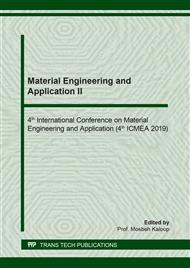[1]
Md. Moniruzzaman, Md. M. A. Bepari, M. M. Haque and S. A. Limon, Corrosion of galvanized steel and copper in aqueous environments, J. Mech. Eng., Vol. ME 43(2) (2013) 61-67.
DOI: 10.3329/jme.v43i2.17828
Google Scholar
[2]
H. Saricimen, A. Ahmad, A. Quddus, A. Akasakal, A. UI-Hamid and T. A. Siddique, Corrosion of bare and galvanized mild steel in arabian gulf environment, J. Mat. Eng. and Perf., Vol. 19(7) (2010) 984-999.
DOI: 10.1007/s11665-009-9565-9
Google Scholar
[3]
E. D. Angel, R. Vera and F. Corvo, Atmospheric corrosion of galvanized steel in different environments in Chile and Mexico, Int. J. Electrochem. Sci., 10 (2015) 7985-8004.
Google Scholar
[4]
J. -B. Vogt, O. Boussac and J. Foct, Prediction of fatigue resistance of a hot-dip galvanized steel, Fatigue Fract. Eng. Mater. Struct., 23 (2001) 33-39.
DOI: 10.1046/j.1460-2695.2001.00365.x
Google Scholar
[5]
Y. Bergengren and A. Melander, An experimental and theoretical study of the fatigue properties of hot-dip-galvanized high-strength sheet steel, Int. J. Fatigue, Vol. 14(3) (1992) 154-162.
DOI: 10.1016/0142-1123(92)90368-m
Google Scholar
[6]
K. Hasegawa, M. Morita and S. Motoda, Effect of microstructure at coating layer on fatigue strength in hot-dip galvanized steel, Tetsu-to-Hagané, Vol. 105(7) (2019) 733-741. (in Japanese).
DOI: 10.2355/tetsutohagane.tetsu-2018-162
Google Scholar
[7]
K. Hasegawa, M. Morita and S. Motoda, Effect of microstructure at coating layer on fatigue strength in hot-dip galvanized steel: submitted to ISIJ Int., (2019).
DOI: 10.2355/isijinternational.isijint-2020-208
Google Scholar
[8]
A. T. Alpas and J. Inagaki, Effect of microstructure on fracture mechanisms in galvannealed coatings, ISIJ Int., Vol. 40(2) (2000) 172-181.
DOI: 10.2355/isijinternational.40.172
Google Scholar
[9]
K. Lee, I. Lee, C. Lee and H. Ahn, In-situ observation in a scanning electron microscope on the exfoliat behavior of galvannealed Zn-Fe coating layers, Surf. Coat. Tech., 201 (2007) 6261-6266.
DOI: 10.1016/j.surfcoat.2006.11.021
Google Scholar
[10]
M. Urai, M. Arimura, M. Terada, M. Yamaguchi, H. Sakai and S. Nomura, Effect of galvanizing and galvannealing conditions on powdering characteristics of galvannealed steel sheet, Tetsu-to-Hagané, Vol. 77(7) (1991) 971-978. (in Japanese).
DOI: 10.2355/tetsutohagane1955.77.7_971
Google Scholar
[11]
G. Reumont, J. B. Vogt, A. Iost and J. Foct, The effects of an Fe-Zn intermetallic containing coating on the stress corrosion cracking behavior of a hot-galvanized steel, Surface and Coatings Tech., Vol. 139(2-3) (2001) 265-271.
DOI: 10.1016/s0257-8972(01)01017-9
Google Scholar


